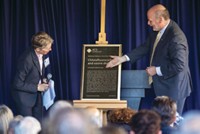Advertisement
Grab your lab coat. Let's get started
Welcome!
Welcome!
Create an account below to get 6 C&EN articles per month, receive newsletters and more - all free.
It seems this is your first time logging in online. Please enter the following information to continue.
As an ACS member you automatically get access to this site. All we need is few more details to create your reading experience.
Not you? Sign in with a different account.
Not you? Sign in with a different account.
ERROR 1
ERROR 1
ERROR 2
ERROR 2
ERROR 2
ERROR 2
ERROR 2
Password and Confirm password must match.
If you have an ACS member number, please enter it here so we can link this account to your membership. (optional)
ERROR 2
ACS values your privacy. By submitting your information, you are gaining access to C&EN and subscribing to our weekly newsletter. We use the information you provide to make your reading experience better, and we will never sell your data to third party members.
Environment
Keeling Curve Named Chemical Landmark
Continual measurements of atmospheric carbon dioxide led to a clearer understanding of climate change
by Linda Wang
August 3, 2015
| A version of this story appeared in
Volume 93, Issue 31

In 1958, geochemist Charles D. Keeling set up an infrared gas analyzer at Hawaii’s Mauna Loa Observatory and began taking measurements of the atmospheric concentrations of carbon dioxide, the most significant greenhouse gas generated through human activities.
Keeling continued tracking daily averages, and over the years a pattern emerged showing steadily increasing levels of CO2 in the atmosphere. The rise, attributed to human activities such as burning coal and other fossil fuels, has only accelerated over the decades. These measurements form the iconic Keeling Curve and laid the foundation for today’s growing concerns about the role of greenhouse gas emissions in global climate change.
To honor Keeling’s transformative work, the American Chemical Society has designated the Keeling Curve as a National Historic Chemical Landmark. The landmarks program, established by ACS in 1992, recognizes seminal achievements in the chemical sciences.
Celebrations took place at both the National Oceanic & Atmospheric Administration’s (NOAA) Mauna Loa Observatory in Hilo on April 30 and Scripps Institution of Oceanography at the University of California, San Diego, on June 12.
It was at Scripps that Keeling analyzed the CO2 data and established the Keeling Curve graph. Representatives at both locations were presented with a commemorative plaque.
Before Keeling began his work, measurements of CO2 in the atmosphere ranged from 150 to 350 ppm. But Keeling’s methods were more precise than those of other researchers and showed surprising consistency around 310 ppm. Today, the Keeling Curve is the longest and most authoritative record of atmospheric CO2 concentrations collected in real time, and both NOAA and Scripps continue Keeling’s air sampling work at Mauna Loa Observatory. Keeling passed away in 2005.
“This meticulous research provided scientifically credible evidence that has proved critical to understanding and addressing human impacts on our environment,” said ACS Immediate Past-President Thomas J. Barton during the ceremony at Mauna Loa Observatory.
Through the landmark designation, ACS is also paying tribute to the researchers within the Scripps CO2 Program, as well as NOAA personnel.
Keeling’s data also shed new light on the carbon cycle, in which carbon moves between Earth’s oceans, atmosphere, biosphere, and geosphere. In addition, Keeling’s research disproved widely held beliefs in the scientific community that exchanges within the carbon cycle could mitigate rising CO2 levels in the atmosphere.
Increasing attention to the role of greenhouse gases in climate change led the United Nations in 1988 to create the Intergovernmental Panel on Climate Change to prepare reports and recommendations about climate change based on scientific information.
In 1992, the UN ratified the UN Framework Convention on Climate Change. Five years later, the Kyoto protocol was formed. This was the first international agreement among member countries to reduce CO2 and other greenhouse gases in the atmosphere.
The commemorative plaques in Mauna Loa and Scripps read, in part: “Keeling advanced our understanding of mankind’s impact on Earth by linking fossil fuel emissions to rising levels of CO2. His dedication to continuous and accurate measurements enabled these data to become an unequivocal record of the global rise in CO2 and an icon of atmospheric science.”
Across the U.S., the National Historic Chemical Landmarks program has awarded landmark status to more than 75 places, discoveries, and achievements in the history of chemical science and technology.
ACS launched the chemical landmarks program to enhance public appreciation for the contributions of the chemical sciences to modern life in the U.S. and to encourage a sense of pride in the practitioners of those sciences.
Prospective landmarks can be nominated by ACS local sections, divisions, or committees.
For more information about the ACS chemical landmarks program, visit www.acs.org/landmarks.






Join the conversation
Contact the reporter
Submit a Letter to the Editor for publication
Engage with us on Twitter